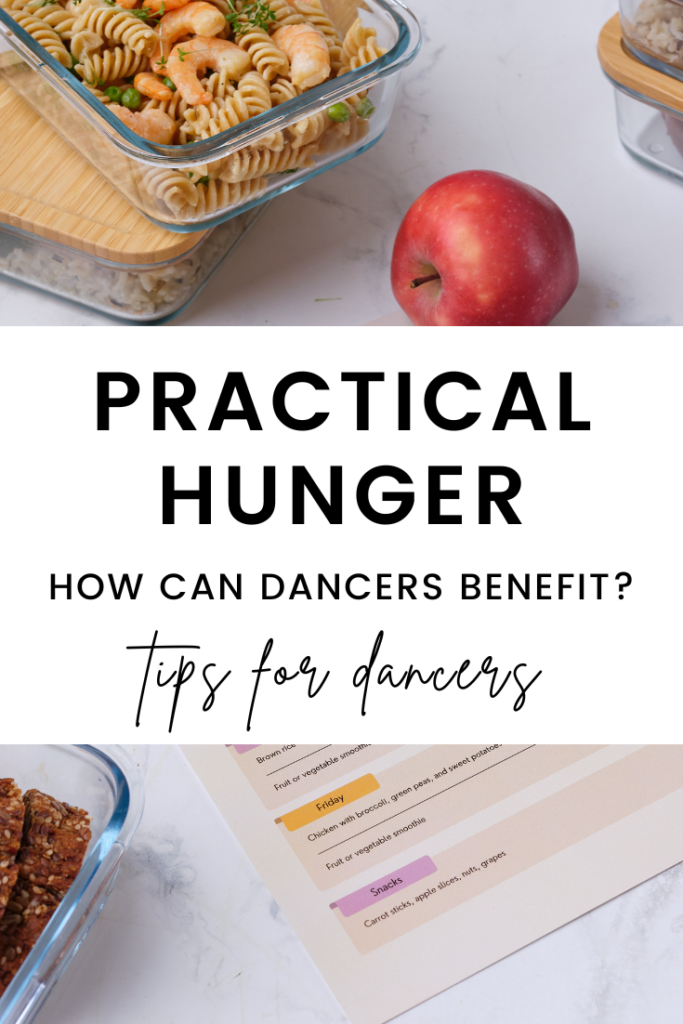As dancers, we’re taught to listen to our bodies— but what happens when your body isn’t sending clear signals? That’s where practical hunger comes in. Practical hunger is one of the five hunger cues dancers can learn to recognize and respond to throughout their day. Unlike more obvious cues like stomach growling or low energy, practical hunger is more subtle and proactive. It’s less about reacting to hunger and more about anticipating your needs.
Honoring this type of hunger is essential to preventing energy crashes, extreme fullness, or rebound eating episodes. It’s a cornerstone of my nutrition method, The Healthy Dancer®, and it supports performance, recovery, and overall well-being.
What Is Practical Hunger?
Practical hunger is the decision to eat even if you’re not experiencing strong physical hunger cues. It’s a mindful, proactive strategy used to fuel the body in anticipation of energy needs, especially given the most common nutritional concerns most dancers face.
For example, you’re heading into a tech rehearsal from 7–11 PM and won’t have time for a meal break. Even if you don’t feel very hungry at 5 PM, eating a balanced dinner beforehand helps sustain your energy and avoids intense hunger or overeating later.
Practical hunger requires flexible meal planning, a skill dancers can use to stay well-nourished during long training days, hectic schedules, or periods of low appetite.
Why Proactive Fueling Matters for Dancers
In my work as a registered dietitian specializing in nutrition for dancers, I’ve found that many dancers struggle to meet their energy needs due to irregular schedules, long training hours, and internalized diet culture. That’s where proactive fueling comes in.
Proactive fueling is the practice of eating in advance of anticipated hunger to:
- Prevent energy dips and fatigue
- Support sustained performance
- Reduce risk of injuries
- Stabilize mood and focus
- Minimize rebound eating
It’s a core tenet of The Healthy Dancer® approach, and it’s especially helpful when traditional hunger cues are absent or unreliable, like on performance days, travel days, or during periods of illness.
When Should Dancers Prioritize Practical Hunger?
Here are common scenarios when dancers should eat, even if they’re not feeling “hungry” in the traditional sense:
- Before long rehearsals or performances: fueling beforehand helps prevent mid-performance fatigue and post-performance overeating.
- During travel or competition weekends, when unfamiliar schedules and limited food access are inevitable.
- On sick days or when appetite is low: your body still needs nourishment to heal, even if your appetite is reduced. Easy-to-digest options like smoothies, soups, or toast can help.
- When recovering from illness or injury, even if your movement is reduced. Your body’s energy needs remain elevated to support healing.
- Before or after emotionally intense experiences, since stress, anxiety, or excitement can blunt appetite. Eating proactively helps stabilize energy and emotion.
5 Signs You’re Not Honoring Practical Hunger
Many dancers struggle with the idea of eating despite feeling hungry. A common question I get is, “Should I eat even when I’m not hungry?” My answer is always yes! Especially if any of these signs feel familiar:
- Nonexistent or delayed hunger cues when you don’t feel hungry until you’re already lightheaded, irritable, or shaky.
- Emotional eating, such as when food becomes your main coping tool, especially after long periods of under-eating.
- Frequent episodes of “over”-eating or feeling out of control around food—especially at night or after rehearsals.
- Mindless eating in response to boredom or exhaustion rather than actual nourishment.
- Emotionally restrictive eating, feeling guilt or anxiety around eating when “not hungry,” even if it supports your performance.
In all of these cases, practical hunger may be your missing link. These patterns often indicate unintentional food deprivation— even among dancers who eat regularly. It’s not just about how often you eat, but how well you meet your body’s needs.
How to Start Honoring Practical Hunger
Whether it’s dialing down a busy schedule to make room for meals or learning how to prioritize a flexible meal plan, developing the skills to honor practical hunger takes practice and patience. Start with these steps:
- Create a loose meal schedule to fuel consistently, even if your appetite is low.
- Pack balanced snacks to bridge long gaps between meals.
- Track your energy and focus to see how proactive fueling impacts your performance.
- Ditch the all-or-nothing mindset. You don’t need to be “starving” to justify eating.
If you’re struggling with low appetite, inconsistent hunger, or energy crashes throughout your dance day, it might be time to consult with a registered dietitian nutritionist. Inside The Healthy Dancer®, we help dancers like you rebuild trust with your body, reconnect with hunger cues, and nourish consistently with both structure and flexibility. Dancers can start for free today and learn how to fuel with intention: Join The Healthy Dancer®.




